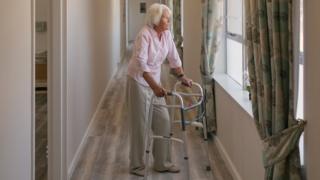 Image copyright Getty Images
Image copyright Getty Images Care home providers have criticised Boris Johnson after he said “too many care homes didn’t really follow the procedures in the way that they could have” during the coronavirus pandemic.
At least 20,000 care home residents in England and Wales have died from Covid-19 since the start of the outbreak.
Vic Rayner, executive director of the National Care Forum, described the prime minister’s comments as “neither accurate nor welcome” and said government guidance to the sector had come “in stops and starts, with organisations grappling with over 100 pieces of additional guidance”.
There are an estimated 14,000 care homes in England. Most are privately run, but are regulated by national bodies and would typically act on advice from central as well as local government.
We don’t know how each of them responded but what was some of the key guidance from government during the pandemic and did it come early enough?
Moving patients from hospitals to care homes
On 19 March, NHS guidance said that “unless required to be in hospital, patients must not remain in an NHS bed”.
This policy was implemented to free up beds in advance of an expected surge in coronavirus patients.
On 2 April, the rules on discharging to care homes were clarified, saying “negative [coronavirus] tests are not required prior to transfers/admissions into the care home”.
Even elderly patients who tested positive could be admitted to care homes, according to the document, if measures – such as wearing personal protective equipment (PPE) and isolation – were used.
From 15 April, the government said that all patients discharged from hospitals would be tested for coronavirus.
By this date, over 28,116 elderly patients had been moved from hospitals to care homes in England but there are no statistics to show how many cases of coronavirus were transmitted this way.
Up to this point more than 5,700 care home residents had died in England and Wales (either in homes or in hospital).
Chris Hopson, head of hospital representative body NHS Providers, said it was “categorically not true” that hospitals were systematically discharging patients to care homes with coronavirus, saying there had been a 40% drop in the number of discharges compared with January.
He added that because “sufficient testing” didn’t come in until mid-April: “It is possible that a very small number of asymptomatic Covid-19 patients [people who had coronavirus but weren’t showing symptoms], who trusts were unable to test prior to that date, were discharged to social care.”
The government has repeatedly said that decisions to discharge patients from hospitals during this time were made by medical professionals on a case-by-case basis.
A Department of Health and Social Care spokesperson said in May: “We have followed a science-led action plan designed at all times to save lives. This week we announced a new £600m infection control fund for care homes… on top of the £3.2 billion we made available in March and April.”
Testing
On 14 March, the government began prioritising the most vulnerable individuals for testing, including those in hospitals and care homes.
If an outbreak was suspected, a handful of residents at a home could be tested.
Reality Check understands that some care providers found access to testing to be very limited at this time.
On 15 April, the social care action plan was launched, as care home deaths in England were peaking at around 400 day. This included a pledge to test all care staff who needed one, for example if they were in a household that was self-isolating.
At that point, just 1,000 care staff had been tested out of an estimated half a million who work in care homes.
All care home residents with coronavirus symptoms would also be tested.
On 28 April, this was extended to all care staff and residents, regardless of whether they had symptoms.
Personal Protective Equipment (PPE)
In March, specific guidance related to coronavirus said that the PPE in care homes should be similar to that used in hospital settings.
The government launched the National Supply Disruption Response on 13 March, a centralised line for care and health providers to raise concerns.
This was followed on 19 March by a promise to deliver 300 masks to each care provider.
Concerns over PPE peaked at the end of March and early April, as bodies such as Unison, the Royal College of Nursing and care homes themselves highlighted shortages.
Because care homes are generally privately-run, they are responsible for purchasing their own PPE. Many found their local suppliers were running low and that they were competing with better-funded hospitals.
A letter from the government on 2 April recognised “the challenges providers may have experienced in obtaining PPE supplies over recent weeks,” and promised that the supply chain would be bolstered, with support from the armed forces.
On 10 April the government announced a PPE action plan, which included freeing up up 34 million pieces of equipment to “local resilience forums” who would then distribute it to care homes through local authorities.
By this point, 3,100 care home residents had died in England and Wales.
Visiting care homes
General guidance produced on 25 February included advice for carers on what to do if they came into contact with someone with Covid-19 – but there was nothing advising against visits to care homes.
In one section it said: “It remains very unlikely that people receiving care in a care home or the community will become infected.”
Another section said: “Currently there is no evidence of transmission of Covid-19 in the United Kingdom. There is no need to do anything differently in any care setting at present.”
However, the government’s own Scientific Advisory Group for Emergencies (SAGE) had advised on 10 February that “it is a realistic probability that there is already sustained transmission in the UK, or that it will become established in the coming weeks.”
On 3 March, the government released its coronavirus action plan – the document did not mention restricting visits to care homes.
By 5 March, England had had 273 cases of people with the virus.
That day the Chief Medical Officer for England Prof Chris Whitty told a committee of MPs that as there were cases that could not be traced back to people who had come from abroad, it was “highly likely therefore that there is some level of community transmission in this virus in the UK now”.
Italy suspended visits to care homes at this point, five weeks after recording its first case. A day later, Nursing Homes Ireland, which represents hundreds of care homes in Ireland, banned non-essential visits, just six days after the first confirmed case in the country.
On 10 March, Prof Martin Green, head of Care England which represents independent care providers, directed criticism in an Independent article at the government for its response.
At this point in England nearly 800 people had caught the virus, but the article noted that the generic guidance published by Public Health England appeared out of date, as it said there was no evidence of transmission within the UK. Prof Green said: “There is no evidence of a plan. I’m not even certain they have these plans and aren’t just making them up as they go along.”
Nevertheless, some homes were deciding to close their doors to visitors, with care groups Barchester and HC-One stopping non-essential visits on 10 March and 12 March.
Scottish Care – a representative body for social care in Scotland – advised care homes to close to visits on 11 March.
On 13 March, the government’s guidance from 25 February was updated to say that “care home providers are advised to review their visiting policy, by asking no-one to visit who has suspected Covid-19 or is generally unwell, and by emphasising good hand hygiene for visitors”.
On the same day Bupa and Four Seasons care homes stopped non-essential visits.
It wasn’t until 16 March that it was announced that social distancing should be carried out by everyone, in particular those aged over 70 and vulnerable people.
That day, the prime minister was asked about care homes and said: “We don’t want to see people unnecessarily visiting care homes.” By this point there had been 3,200 cases in England (although the figure given by the authorities at that point was less than half of that; positive cases are now dated to the day the sample was given).
In the period between 25 February and 16 March, 14 deaths of care home residents were reported along with 30 outbreaks in England’s 15,000 care homes.
On 21 March, guidance was introduced to encourage medically vulnerable people to remain indoors as much as possible until the end of June – a process known as shielding.
On 24 March, lockdown began with people ordered not to leave their homes at all except for “essential” reasons, which didn’t include visits to care homes.
Finally, on 2 April another document from the Department of Health and Social Care said that “family and friends should be advised not to visit care homes, except next of kin in exceptional situations such as end of life”.
Speaking on 15 May, Health Secretary Matt Hancock said that on the basis of the 13 March guidance “many of the care home providers, for instance Care UK, at that point stopped visitors”.
Source: BBC News – Health








